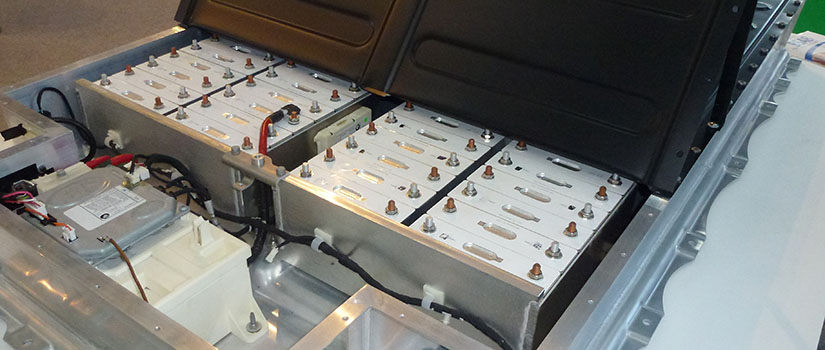Pictured above: A lithium-ion battery pack for a BMW i3 electric vehicle. Photo by Rudolf Simon.
CEC researchers urge caution when operating li-ion batteries at low temperatures
With global EV sales rising 80% in 2021, more consumers than ever are driving battery-powered vehicles. Although the trend is positive for decreasing our reliance on fossil fuels, College of Engineering and Computing researchers at the University of South Carolina have found possible tragic consequences associated with of using and storing EV batteries in varying temperatures.
Chemical engineering professors Paul Coman, William Mustain and Ralph White, as well as former Ph.D. student Ben Ng found that toxic gases, such as fluorinated compounds and volatile organics, can be released from lithium-ion batteries after charging and discharging at low temperatures. In fact, the battery can remain a safety concern after returning it to room temperature and even lead to potential catastrophic events like fires or explosions. The team recently published their findings in an article published in Applied Energy Materials.
Knowing that lithium plating was more likely to occur at low temperatures, the research team wanted to study how battery cells would behave in these conditions. Plating is the process where lithium metal forms on the electrodes that may cause a short circuit. Lithium ions are transported between the negative electrode and positive electrode in a healthy cell, but at low temperatures, lithium ion on the surface of the carbon electrode can be plated into the carbon. This forms lithium metal deposits that can grow like branches and cause short circuits in multiple places.
According to Ng, who now works at the Lordstown (Ohio) Motors Corporation as lead engineer for battery technology for testing and modeling, the research on lithium-ion batteries was reminiscent of an older technology.
“Like titanium disulfide batteries, lithium-ion batteries are prone to the same lithium plating and stripping events when operated under extreme conditions, which has its own safety concerns. Lithium metal is highly reactive if it encounters almost any other material like the electrode. It will spontaneously react and cause degradation in the battery or catch on fire,” Ng says.
Previous journal articles specified that plating at low temperatures may cause an explosion. The CEC research team cycled one battery at low temperature before continuously charging and discharging at room temperature. While the cell did not explode, it vented and released toxic and flammable gases, which allowed the researchers to disassemble and analyze the internal battery cell components.
“Testing one cell in large lab conditions and then inside a controlled thermal chamber is easier to contain and analyze. But we were thinking, what if this happened where someone was operating an EV or drone in low temperatures for a long time, then store or recharge it at room temperature after low-temperature cycling?” Coman says. “An EV has thousands of batteries under the seat, in the trunk or under the car, and gases like carbon monoxide, which can be fatal in large amounts. It was important to share because there might be situations where someone does not realize what is happening.”
Several charging and discharging of lithium-ion cells were performed at -29 degrees Celsius. After lithium-ion batteries were cycled, Ng disassembled the cells and removed the electrodes. These were assembled in a jelly roll configuration that is typical for the cylindrical cells that are present in almost every application, including EVs. He analyzed the gases and identified the elements on the surface of the anodes and cathodes where the plating was occurring.
“Our research tried to figure out what happens when lithium metal is deposited onto the surface of the carbon electrode. The lithium metal corrodes in the presence of the electrolyte to form decomposition products,” Ng says. “We also found reactive gases such as ethylene from the decomposition reaction and some additional phosphorus and fluorine compounds. There is internal pressure buildup inside the battery as gases evolve at low temperature, which can lead to significant safety concerns.”
Ng added that the pressure builds up, and the electrodes are squeezed together. “In the event that two electrodes touch each other, you can have a direct passage of current which generates a lot of heat. The high heat ignites flammable gases, which leads to catastrophic events,” Ng says.
Coman explained that because the electrodes are coiled in a cell, the battery moves, expands and contracts when it is cycled, charged and discharged. “As a result, it made a ripple-type deformation. We found that there are different states of charge and a wave-type of structure on the electrodes,” Coman says.
There are several scenarios that can occur at low temperature, such as a solidification of the electrolyte, which impedes the movement of lithium ions and rapidly increases the internal resistance of the battery. The rates of chemical reactions are also hindered at low temperature, which can enable unwanted side reactions and decomposition products.
Since he currently works with batteries and EVs, Ng has implemented some of his previous research at the CEC to mitigate harmful processes with battery management systems to help prevent catastrophic fires or explosions. This includes cutting off when maximum values are reached or cutting off currents to prevent charging at low temperatures. The CEC research team hopes their findings can increase safety for the millions of people driving EVs in the coming years.
